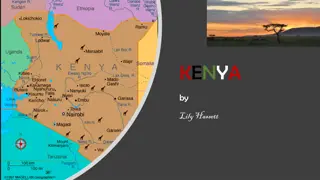Improving Inventory Tracking System for Public Health in Kenya
A pilot project in Kenya aimed at building a sustainable inventory tracking system for medicines using existing tools to address challenges such as delays in approval processes and inaccurate inventory data. By deploying a lightweight survey platform in two counties, the project successfully monitored stock levels in real time, providing valuable data to ensure adequate supply of medicines. The system proved to be flexible, scalable, and applicable to other countries, offering a promising solution to streamline inventory management in public health settings.
Download Presentation

Please find below an Image/Link to download the presentation.
The content on the website is provided AS IS for your information and personal use only. It may not be sold, licensed, or shared on other websites without obtaining consent from the author. Download presentation by click this link. If you encounter any issues during the download, it is possible that the publisher has removed the file from their server.
E N D
Presentation Transcript
DOWNSTREAM INVENTORY TRACKING PILOT IN KENYA
What challenge are we aiming to tackle? Objectives: - 1. Build a sustainable, lightweight subnational Inventory Tracking system using existing and familiar tools (NTDeliver, SDK Survey Platform) Two key challenges:- 1. Lack of inventory data delayed approval of JRSM 2. Show the full lifecycle of medicines from request to use: 2. Out-of-date and or inaccurate inventory data over/short supply JAP (Request) NTDeliver (Purchase order) KEMSA (Distribution in country) District Pharmacy (Distribution for MDA)
Tool Deployed in 2 counties in Kenya Homabay County Migori County 8 Districts 8 Districts Subject NTD drug: Praziquantel (PZQ) 600mg tablets (Cesol)
How it works Survey emailed and WhatsApp din August 2020 (after MDA1 in November 19) and again in October 2020 (after MDA2 in September). Data was aggregated on a real time dashboard that could monitor what districts reported and what their stock levels were. Survey and dashboard are accessible on desktop and mobile.
About the Survey 1. Survey collects basic data from district pharmacists and/or NTD personnel 2. Survey was prepopulated with data already in NTDeliver including batches and expiry dates 3. This minimizes data input and enhances overall data quality
Dashboard Dashboard was created that combines data from: 1. ESPEN (JRF / JRSM) 2. NTDeliver (PO Request to Kenya_ 3. KEMSA (Distribution to subcounty) 4. Subdistrict Inventory Link to dashboard can be found in NTDeliver Tools Inventory Kenya (PZQ) https://dashboards.securedatakit.com/public/dashboard/4c6f970d-f51c-4c5b-abeb- e81d6105f6e5?country_id=22&programme_id=3
District Results Homabay 100% districts reported 6 districts had zero stock at end of October 2020 2 districts had 163,500 tablets (est.) at end of October 2020 Migori 100% districts reported 6 districts had zero stock at end of October 2020 2 districts had 55,500 tablets (est.) at end of October 2020
Overall Assessment 1. Flexible and rapidly deployable 2. Scalable to other countries and not dependent on country-allocated infrastructure (e.g. SMS / Shortcode availability) 3. Real time data available to MoH and partners 4. Ability to integrate with global / regional/ national systems (e.g. country LMIS / ESPEN) to simplify data sharing 5. Accountability tool (i.e. who has reported and what did they report) proved popular among MoH team




















